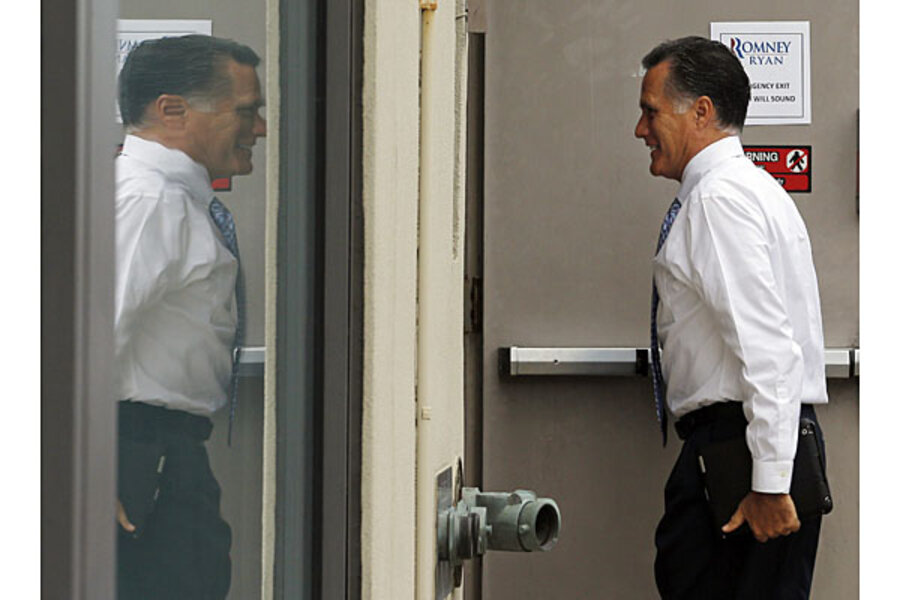Presidential debate: The details (or lack thereof) of Romney's tax plan
Loading...
From Wednesday's debate (emphasis added to NPR transcript):
MR. ROMNEY: Well, sure. I’d like to clear up the record and go through it piece by piece. First of all, I don’t have a $5 trillion tax cut. I don’t have a tax cut of a scale that you’re talking about. My view is that we ought to provide tax relief to people in the middle class. But I’m not going to reduce the share of taxes paid by high- income people...
…look, I’m not looking to cut massive taxes and to reduce the — the revenues going to the government. My — my number one principle is there’ll be no tax cut that adds to the deficit.
I want to underline that — no tax cut that adds to the deficit. But I do want to reduce the burden being paid by middle-income Americans. And I — and to do that that also means that I cannot reduce the burden paid by high-income Americans. So any — any language to the contrary is simply not accurate.
First, Romney says he will have “no tax cut that adds to the deficit.” How to reconcile this with not raisingburdens on “middle-income” Americans and not reducing burdens on “high-income” Americans–given the Tax Policy Center’s analysis of the kind of base broadening needed to support a 20% across the board reduction in marginal income tax rates (in addition to the proposed extension of the full complement of Bush tax cuts) andno increase in effective tax rates on capital income?
A few possibilities I see: (i) Romney is willing to back off the 20% figure for the marginal tax rate cuts; (ii) Romney is implicitly fiddling around with his definition of “middle income” vs. “high income” (consistent withMartin Feldstein’s point that you might be able to avoid raising burdens on middle-income households as long as “middle-income” ends at $100,000); and/or (iii) Romney is using “dynamic scoring” assumptions that assume growth effects offset any “static” revenue loss. Some combination of those three tradeoffs is being exploited here.
Second, Romney says he is “not going to reduce the share of taxes paid by high- income people.” How to reconcile this with reducing marginal tax rates and keeping capital income tax expenditures out of the tax base? Well, two cautions here, noting what Romney is literally saying:
- If the Romney plan is actually revenue losing, then maintaining the high-income households’ share of a smaller overall tax burden would still imply a reduction in the progressivity of the income tax system–”progressivity” referring to the existing pattern of rising average tax burdens (taxes paid/income) at higher income levels. A constant share of a shrinking progressive policy means the rich person’s burden, relative to his or her income, goes down more than it does for someone with lower income. The reference to “shares of taxes paid” was a favorite way of talking about the (claimed “increased”) progressivity of the Bush tax cuts by the Bush Administration. Given that a lot of the Romney advisers are the same people who created, promoted, and managed the Bush tax cuts (way back in 2001), the use of this statistic to advertise the “fairness” of the Romney plan is not at all surprising.
- Exactly who are the “high-income people” in this category? (Go back to point (ii) above, regarding the deficit-neutrality claim.) As the Tax Policy Center pointed out in their response to the Feldstein critique, if we change the definition of “high income” to above $100,000 instead of above $200,000 or $250,000, it’s much easier to keep the burdens of this much broader category of households constant (or higher), by paying for net tax cuts on those above $200,000, with net tax increases on those between $100,000 and $200,000. You can technically call that “not a reduction” in the tax burdens of (all) “high-income people” (meaning the aggregate category of people with income above $100,000), but most of us wouldn’t find that a sensible way to increase the “fairness” of the tax system.
So Romney was very effective in Wednesday night’s debate at making his tax plan sound, contrary to the President’s claims, both fiscally responsible and fair, but that’s because he was just able to declare it without explaining the details. And the President coming back with the details of the TPC analysis didn’t work as well as it did when he first touted the analysis two months ago in his campaign speeches and TV ads. (CNN’s real-time sentiment meter of their sample of Colorado undecided voters recorded that point in Obama’s remarks as his lowest point in last night’s debate, in fact.) And the debate moderator certainly didn’t follow up with the questions I would have.






